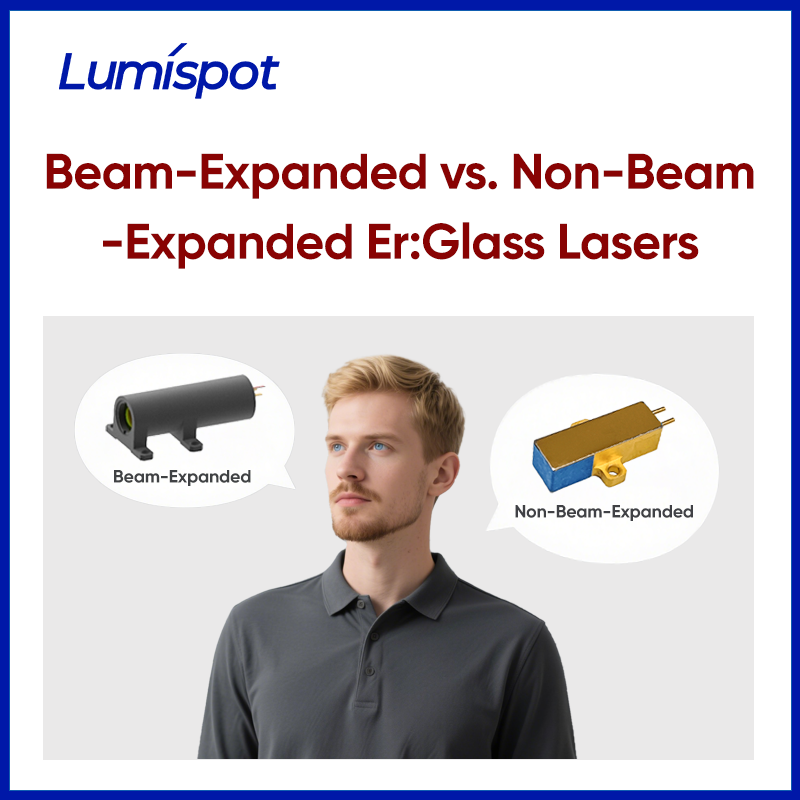In applications such as laser ranging, target identification, and LiDAR, Er:Glass lasers are widely adopted due to their eye safety and high stability. In terms of product configuration, they can be classified into two types based on whether they integrate a beam expansion function: beam-expanded integrated lasers and non-beam-expanded lasers. These two types differ significantly in structure, performance, and ease of integration.
1. What Is a Beam-Expanded Integrated Laser?
A beam-expanded integrated laser refers to a laser that incorporates a beam expander optical assembly at the output. This structure collimates or expands the originally divergent laser beam, improving the beam spot size and energy distribution over long distances.
Key features include:
- Collimated output beam with a smaller spot size at long range
- Integrated structure that eliminates the need for external beam expanders
- Enhanced system integration and overall stability
2. What Is a Non-Beam-Expanded Laser?
In contrast, a non-beam-expanded laser does not include an internal beam expansion optical module. It emits a raw, divergent laser beam, and requires external optical components (such as beam expanders or collimating lenses) to control beam diameter.
Key features include:
- More compact module design, ideal for space-constrained environments
- Greater flexibility, allowing users to choose custom optical configurations
- Lower cost, suitable for applications where beam shape at long distances is less critical
3. Comparison Between the Two
① Beam Divergence
Beam-expanded integrated lasers have a smaller beam divergence (typically <1 mrad), while non-beam-expanded lasers have a larger divergence (typically 2–10 mrad).
② Beam Spot Shape
Beam-expanded lasers produce a collimated and stable spot shape, whereas non-beam-expanded lasers emit a more divergent beam with an irregular spot at long distances.
③ Ease of Installation and Alignment
Beam-expanded lasers are easier to install and align since no external beam expander is required. In contrast, non-beam-expanded lasers require additional optical components and more complex alignment.
④ Cost
Beam-expanded lasers are relatively more expensive, while non-beam-expanded lasers are more cost-effective.
⑤ Module Size
Beam-expanded laser modules are slightly larger, whereas non-beam-expanded modules are more compact.
4. Application Scenario Comparison
① Beam-Expanded Integrated Lasers
- Long-range laser ranging systems (e.g., >3 km): The beam is more concentrated, which enhances echo signal detection.
- Laser target designation systems: Require precise and clear spot projection over long distances.
- High-end integrated electro-optical platforms: Demand structural stability and a high level of integration.
② Non-Beam-Expanded Lasers
- Handheld rangefinder modules: Require compact size and lightweight design, typically for short-range use (<500 m).
- UAVs/robotic obstacle avoidance systems: Space-constrained environments benefit from flexible beam shaping.
- Cost-sensitive mass production projects: Such as consumer-grade rangefinders and compact LiDAR modules.
5. How to Choose the Right Laser?
When selecting an Er:Glass laser, we recommend users consider the following factors:
① Application distance: For long-range applications, beam-expanded models are preferred; for short-range needs, non-beam-expanded models may suffice.
② System integration complexity: If optical alignment capabilities are limited, beam-expanded integrated products are recommended for easier setup.
③ Beam precision requirements: For high-precision measurement applications, lasers with low beam divergence are recommended.
④ Product size and space constraints: For compact systems, non-beam-expanded designs are often more suitable.
6. Conclusion
Although beam-expanded and non-beam-expanded Er:Glass lasers share the same core emission technology, their different optical output configurations lead to varying performance characteristics and application suitability. Understanding the advantages and trade-offs of each type helps users make smarter, more efficient design choices and improves overall system performance and stability.
Our company has long been dedicated to the R&D and customization of Er:Glass laser products. We offer a wide range of beam-expanded and non-beam-expanded configurations across various energy levels. Feel free to contact us for more technical details and selection advice tailored to your application.
Post time: Jul-30-2025

